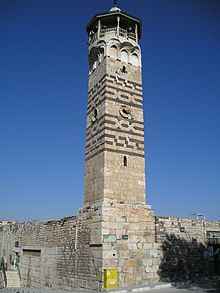User:Zozo2kx/Nur
| Nur Al-Din Mosque جامع نور الدين | |
|---|---|
 The minaret of Nur al-Din Mosque | |
| Religion | |
| Affiliation | Islam |
| Region | Levant |
| Status | Active |
| Location | |
| Location | |
| Geographic coordinates | 35°8′6″N 36°45′9″E / 35.13500°N 36.75250°E |
| Architecture | |
| Type | Mosque |
| Style | Zengid |
| Completed | 1172 |
| Specifications | |
| Minaret(s) | 1 |
| Materials | Basalt, Limestone, Tiles |
The Nur Al-Din Mosque (Arabic: جامع نور الدين, transliteration: Jami Nur al-Din) is a Zengid-era mosque in Hama, Syria, located on the banks of the Orontes river.[1] The mosque was erected by Nur ad-Din Zangi in 1172. The square minaret, made of alternating bands of black basalt and yellow limestone, is the mosque's strongest feature. Inside the mosque, the intricately carved wooden minbar still stands as one of the oldest preserved testaments to Islamic history.[1]
Architecture[edit]
The building, in its current form, retains the shape of its first period, its foundation by Nur al-Din, though some parts may have been replaced. Its second period was dominated by Ayyubid architecture laid by the two Ayyubid Sultans of Hama, al-Malik al-Muzaffar II Mahmud (626-42), and Abu al-Fidaa (710-733). Al-Malik al-Muzaffar probably altered the roofing of the main prayer hall, and added the two elongated rooms beyond the east wing, where Abu al-Fidaa added his mihrab. The third, and latest, period came in the shape on an Ottoman reconstruction of the west wing and the addition of a chamber for the imam.
References[edit]
- ^ a b Nur al-Din Mosque Archnet Digital Library.
Bibliography[edit]
- Rihawi, Abdul Qader (1979). Arabic Islamic Architecture: Its Characteristics and Traces in Syria. Publications of the Ministry of Culture and National Leadership.
Category:Buildings and structures completed in 1172 Category:Mosques in Hama Category:Arabic architecture




